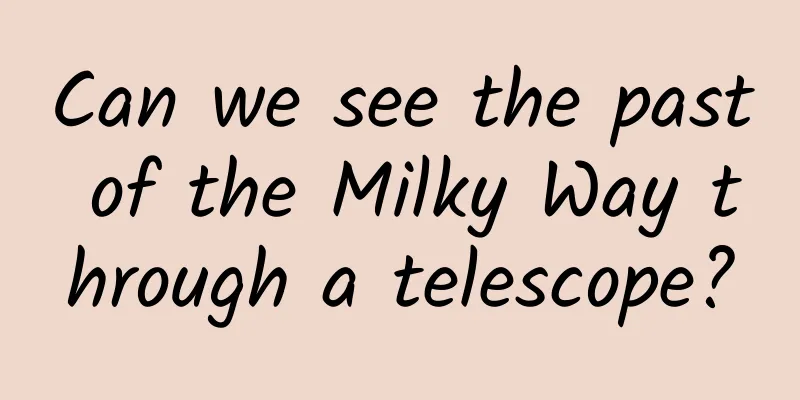Can we see the past of the Milky Way through a telescope?

|
The light-time equivalence mentioned here is not a rigorous scientific term, but a scientific understanding of space-time communication. What is strictly in line with scientific common sense is that the speed of light and time have a direct proportional relationship, and the speed of light multiplied by time equals distance. This understanding includes the following deductions: The speed of light is the fastest speed in the universe. The exact value of the speed of light in a vacuum is 299,792,458 meters per second, and 300,000 kilometers per second is generally used. Any object seen by the human eye relies on light transmitted to the retina. These lights include light from the light source, as well as reflected, refracted, diffracted, and scattered light. No matter what kind of light it is, its speed is about 300,000 kilometers per second. Various kinds of light depict the appearance of the object itself, and then transmit it to people's retinas at the speed of light, so that we can see the object. Therefore, the farther the object is, the longer it takes to propagate; the shorter the distance, the shorter the propagation time. This is what I call the equivalence of light and time. Based on how long it takes for the object we see to be transmitted, we can measure the distance between the object and us; or in other words, if we know the distance of the object, we can know how long it takes to be transmitted. This is the delay we produce when we see the object, from which we can deduce the time-distance equivalence (time and distance equivalence). The so-called delay in seeing objects means that any object we see is not the instantaneous appearance, but the appearance in the past. For example, any object 100 meters away from us will always be the appearance 3 millionths of a second ago; the moon is 384,400 kilometers away from us on average, so what we see will always be the appearance more than 1 second ago; the sun is 150 million kilometers away from us, so what we see will always be the appearance 8 minutes ago. In cosmic observation, the unit of measure used is generally the light year. A light year is the length of a vacuum light speed running continuously for one year. The scientific community uses the Julian year to calculate light years. A year is 365.25 days, or 31,557,600 seconds, so the scale of a light year is 94,607,304,725,808 meters, and 9.46 trillion kilometers is generally used. Therefore, the celestial bodies we see are so many light years away, and the light has traveled so many years to transmit the image of the celestial bodies to our eyes, so the celestial bodies we see can only be what they looked like so many years ago. This leads to a question: can we see the past of many galaxies, can we see the past of our own Milky Way? I think this is possible based on existing theories. The current Hubble Telescope has seen a galaxy 13.4 billion light-years away from us, numbered GN-z11. This galaxy is only 400 million years old from the Big Bang. This galaxy belongs to the infant galaxy, about 1/25 of the size of the Milky Way and only 1% of the mass of the Milky Way. The Milky Way is 13.4 billion years old, and the GN-z11 galaxy should have been born at about the same time. So is the Milky Way among the group of baby galaxies that people see 13.4 billion years ago? Because if the telescope can see all the ancient galaxies formed in that era, the Milky Way should be among them in theory. The Webb telescope, which is more powerful than the Hubble telescope, has been launched. It is said to be able to bring distant celestial bodies closer by another 400 million light-years, which means that celestial bodies 13.8 billion light-years away can be seen. At that time, the universe was only 20 million light-years away from the Big Bang, and galaxies may not have appeared yet. In that chaotic nebula, the Milky Way was of course included. Therefore, I think that in theory, as long as the telescope can see far enough, according to the principle of light-time equivalence and time-distance equivalence, as well as the principle of observation delay, it is possible to see the past of the Milky Way. And when technology develops to a certain level and human observation capabilities are greatly improved, it will be possible to observe all the processes of the Milky Way from its birth to its evolution. Research suggests that the Milky Way collided and merged with a galaxy called Gaia Enceladus 11 billion years ago to become the galaxy it is today. The collision and fusion process accelerated the formation of stars, and this process ended 8 billion years ago. How exciting it would be to observe this process. After the Big Bang, there was a dark period. The standard cosmological model recognized by the scientific community holds that the Big Bang occurred 13.82 billion years ago. At the beginning of the Big Bang, due to the extremely high temperature and density, photons (electromagnetic waves) could not escape. Humans now rely on light to observe the world. Without light, nothing can be seen. Therefore, the universe during this period was opaque and was called the Dark Ages. It was not until 380,000 years later that the universe expanded large enough and the temperature dropped to about 3,000 degrees, that neutral atoms began to form, electromagnetic waves and photons were able to decouple, and the universe became transparent and observable. Therefore, the first ray of light in the universe was emitted 380,000 years after the Big Bang. The cosmic microwave background radiation that has been discovered everywhere is the embers of the Big Bang left at that time. At that time, atoms had just been born, and there were only the simplest and lightest atoms in the universe, including hydrogen atoms and helium atoms, and a very small amount of lithium. It was these atoms that gradually condensed under the action of gravity and gradually formed nebulae. The continuous contraction of nebulae gradually formed galaxies and stars. If the Webb telescope can see the time when the first ray of light was emitted, all galaxies had not yet been formed, and all celestial bodies and matter in the universe were contained in these chaotic nebulae, including the Milky Way. The universe at this time was a true infant universe. So, in this sense, as long as we can see the universe of this period, the shadow of the Milky Way is certainly included in it. This is the past of the Milky Way, and we cannot help but see it. So, will this dark history from the Big Bang to 380,000 years really never see the light of day? Is it possible for humans to uncover this dark secret? The discovery of gravitational waves provides the possibility to uncover this dark secret. The standard cosmological model believes that gravity is the first fundamental force to appear after the Big Bang, and it appeared at the Planck time. The Planck time is 10^-43 seconds after the Big Bang, which is one trillionth of a trillionth of a second after the Big Bang. At this time, the universe has emerged from the background of quantum fluctuations, but only at the Planck scale. The Planck scale is about 1.6*10^-35 meters, which is one billionth of a meter. At this time, the density of the universe reaches 10^94 grams per cubic centimeter, and the temperature is also the Planck temperature, about 10^32 degrees. However, at this time, the gravitons that transmit gravitational interactions have separated and exist independently, and universal gravitation has appeared. Einstein had predicted the existence of gravitational waves long ago. In 2016, scientists discovered and detected gravitational waves for the first time, thus opening a new era of cosmic exploration. Scientists believe that through the detection of gravitational waves, it is possible to understand the conditions of the dark period between the Big Bang and 380,000 years ago. This shows that gravitational waves can make up for the shortcomings of human eyes. In the future, humans may indirectly see the moment when the Big Bang began, as well as the inflation process and various events between 380,000 years through gravitational waves. By then, humans will be able to understand the entire evolution of our universe from its birth to the present, as well as various major events that occurred during this period. In the context of the universe, the Milky Way is no exception. According to the principle of light-time equivalence and time-distance equivalence, theoretically we can not only see the past of the Milky Way, but also the birth and evolution of the sun and the earth. Although it is not possible now, I believe it will be possible in the future. What do you think? Welcome to discuss, thank you for reading. This is the original copyright of Space-Time Communication. Please do not copy or infringe upon the copyright. Thank you for your attention and support. |
<<: A letter from the CDC to people who have not been vaccinated against the new coronavirus
>>: Today is Grain Full: Wheat ears are just beginning to grow and mulberry leaves are growing
Recommend
If a large planet suddenly enters the solar system and blocks all sunlight on Earth, will life become extinct?
This article is based on answering a question fro...
Data Brother's online advanced course on live streaming sales operation allows ordinary people to make money through live streaming
Course Catalog 1. Course Introduction 2. Comprehe...
Mini Program advertising space is now online! Starting from 0.5 yuan per click, how to grab traffic bonus?
I finally waited for you, and luckily I didn’t gi...
Why do I fall asleep easily when I'm in a car? How did I get "hypnotized"?
In daily life I believe many people Have had this...
China and Japan cooperate to unify charging standards and build charging piles, which may significantly reduce costs
Recently, the China Electricity Association decid...
Where can I make a 400 phone call? What are the charges for 400 phone calls?
How much are 400 calls charged? What are the char...
6 steps to quickly get started with growth hacking
Growth hacking is not a new concept in China. How...
YouTube Ad Creation Basics Tutorial!
How to create a YouTube ad campaign? Determine th...
2019 Kuaishou and Douyin User Research Report!
The following is the full report: (Reply "DK...
It is said online that watching horror movies can help you lose weight, but I advise you to be cautious!!
I saw a short video some time ago: watching horro...
The Webb telescope, which is so powerful, actually has this "dark history"
The astronomical community has had a great event ...
Apple Watch Sport disassembly: Component cost is 500 RMB
Market research firm IHS iSuppli released a disas...
E-commerce operations, customer acquisition ideas for social e-commerce group buying!
Friends who have been paying attention to the e-c...
Google launches new Qaya service: Help creators easily build online stores
The new project, Qaya, co-founded by Nathaniel Na...
The payment war between WeChat and Alipay is still escalating. Can the banks’ counterattack win back lost customers?
The popularity of WeChat and Alipay has driven th...









